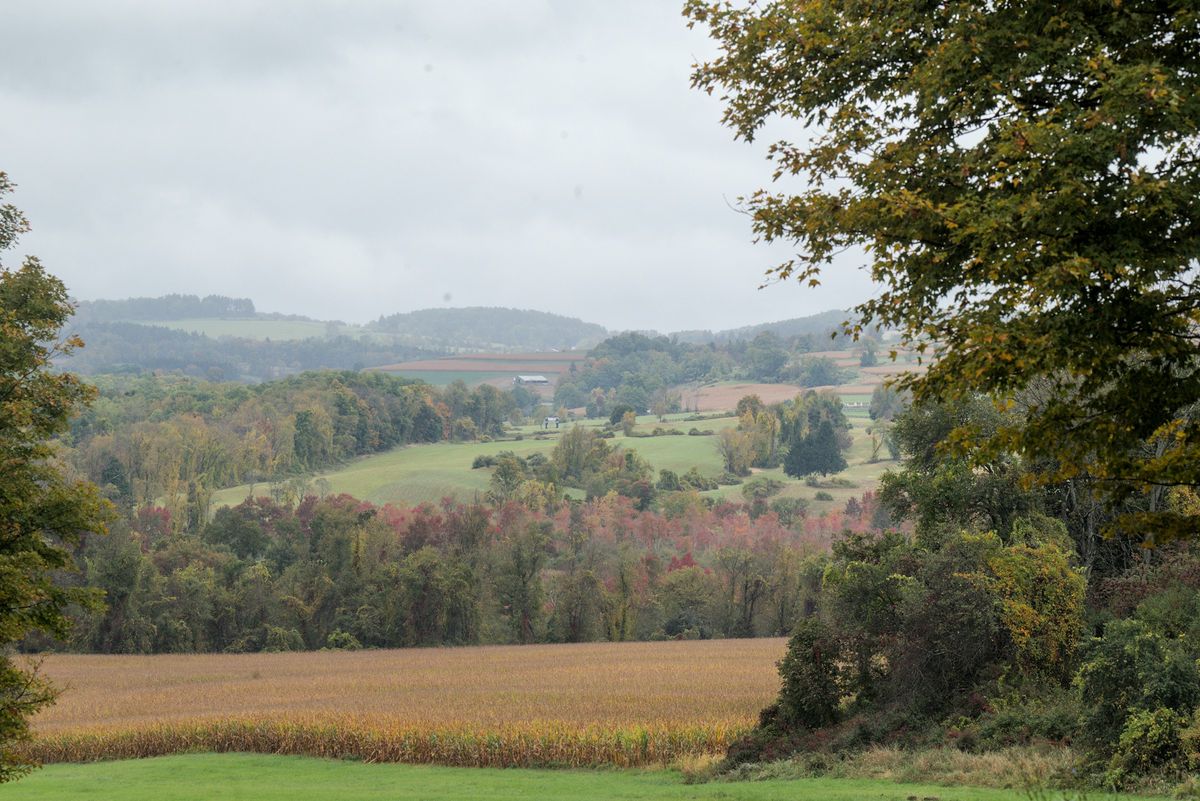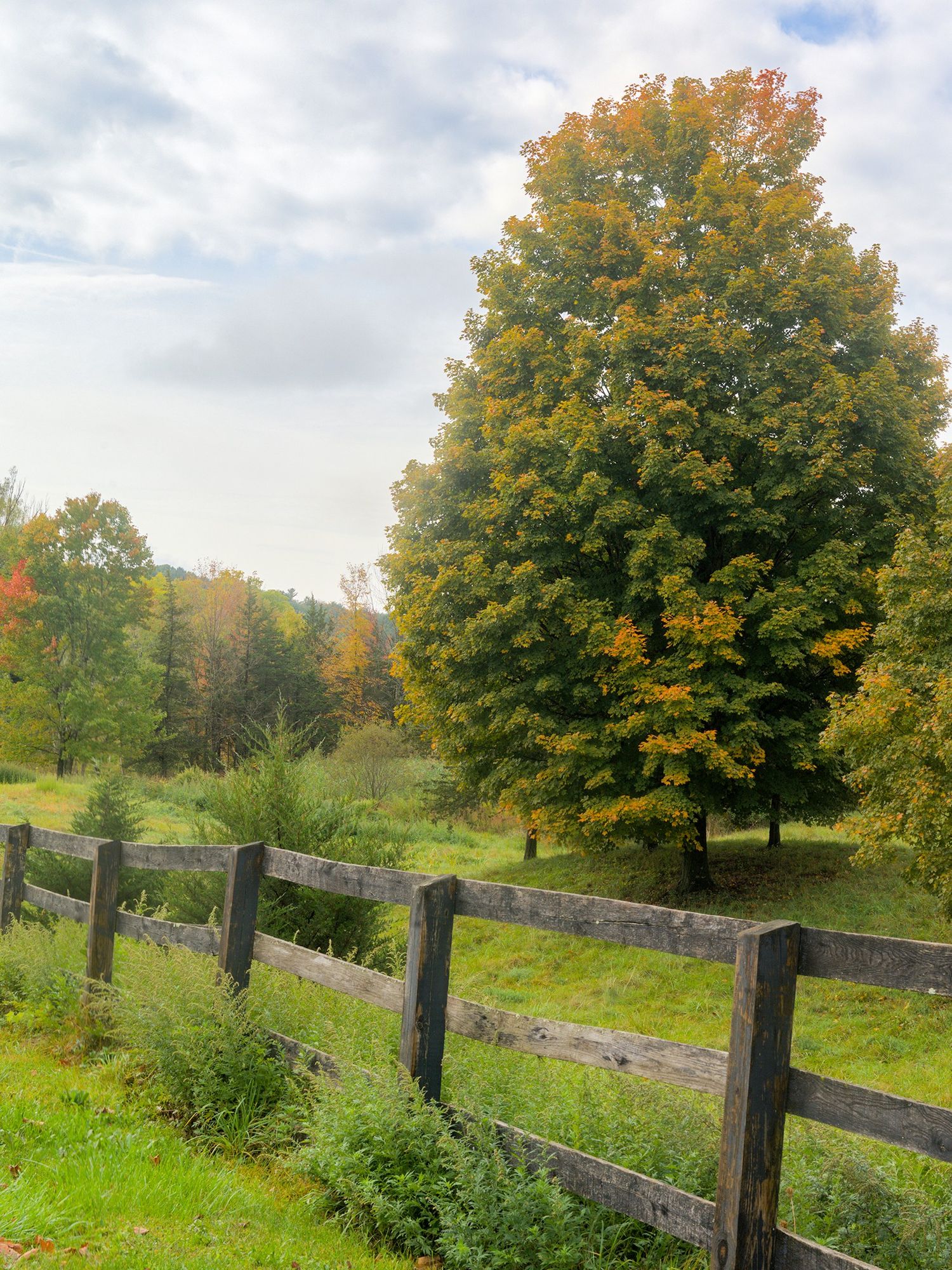Trees begin to turn with the official start of autumn

A reddish hue develops along the ridgelines of the Northwest Corner as cold air begins to turn the leaves with the arrival of fall.
Nathan Miller

A reddish hue develops along the ridgelines of the Northwest Corner as cold air begins to turn the leaves with the arrival of fall.
Sunday, Sept. 22 marked the beginning of astronomical fall, and our trees are showing it.
Flecks of red, yellow, orange and gold dot the hillsides and maples wear mottled coats of green and fiery orange alongside the roadways. It’s certainly still the early stages of foliage season, but Kent Tree Warden Bruce Bennett said in a recent interview that this timing was not always the norm.
“I’ve been around for 70 years,” he said, explaining that fall color used to begin around Sept. 5 and peak near Sept. 21. That peak date has “slowly but surely moved almost a month” to mid-October, he said, as a product of warmer and later autumns resulting from climate change.
A late-September leaf change matches the pattern of recent fall seasons. Bennett said red maples are among the best indicators for when autumn arrives. “They’re always the first tree to start to change,” he said, further explaining that the red maple usually provides the most vibrant color — “some pretty good red and deep orange.”
Bennett maintained that while people tend to think of sugar maples as the star of our fall season, it’s actually the red maples that really make the show. However, this year, he has high hopes for the sugar maples: “when they have a good year, they’re spectacular, and it looks like this might be a good year for the sugar maples.”
Predicting a foliage season is notoriously difficult. Bennett said that while people often talk about dry or wet weather in the fall as indicative of how bright the colors will be, “no one really knows.” He explained that there are many other complicating factors that can alter foliage vibrancy, including weather going back to the previous year and beyond. He said that last year’s season was spectacular during a really dry year, while five years before that was equally striking, but during a very wet year.

Despite the uncertainties, Bennett said it will probably be another week or two before the region’s foliage reaches the 50% mark.
Further complicating things is the presence of disease in the region’s trees. Large numbers of maples this autumn have already had leaves shrivel up and turn brown, and in many cases have already fallen from the tree. Bennett explained that this is due to a common fungal disease called anthracnose that has proliferated in the canopy due to the unusually hot and humid summer.
While it will dampen the color by taking many of the brighter trees out of the picture, it is normally not harmful to the tree itself — the tree is simply shedding diseased leaves. Bennett said that leaves where the foliage is dense are the most affected as the fungus spreads by moisture. Well ventilated trees, such as those in clearings or more spacious forests, should remain free of the disease and produce their normal color.
Wake Robin Inn Innkeeper Michael Loftus upheld that these uncertainties and inconsistencies in the foliage season have caused any vestige of a foliage tourist season to largely disappear. “Is fall foliage even a ‘season’ anymore for our parts,” he asked. He said the fall was still a great season for the Inn, but due to group bookings for weddings or parents weekend visits for the region’s boarding schools, not foliage tourism.
Susan Sweetapple, owner of the Falls Village Inn, agreed that it can be hard to parse out the leaf peeping crowd from other types of autumn visitors, like parents weekend trips or events at Lime Rock Park, which has a busy program this season.
Other innkeepers felt that foliage tourism is alive and well in the region. John Ciliberto, manager at the White Hart Inn, maintained that “fall foliage will always be a reason to come to the Northwest Corner of Connecticut.” He maintained that leaf peeping, alongside other autumn-themed events such as Salisbury’s Fall Festival and Handmade Fair, causes a noticeable uptick in traffic from mid-September through the end of October.
Innkeeper Kevin Bosquet, who has been at the Interlaken Inn for 41 years, agreed that the region “absolutely” still has a foliage season. The season is enchanting, he said, especially for visitors from the cities who don’t have the same access to trees at home – “it takes everyone back to their childhood,” he said.
As for residents, the season is certainly here, and the trees show it. Bennett is confident that this year won’t disappoint for those who are willing to look for the beauty: “We always have a good fall,” he said, “it’ll be good.
Kathy Chow, pictured here standing, addresses the room during public comment on the proposed overhaul of North East's zoning code. Chow suggested more farming opportunities should be permitted in the code.
MILLERTON – Community members crammed into the North East Town Hall on Thursday, Jan. 8, for a highly anticipated public hearing on the town’s proposed commercial zoning overhaul.
With the 21-seat meeting room at capacity, several attendees were forced to listen from the lobby. After listening to public comments, the town board opted to adjourn the hearing rather than close it, scheduling a continuation for Tuesday, Feb. 3, at 6 p.m.
The hearing marked a significant milestone in a process that has been four years in the making and represents the first comprehensive rewrite of the town’s zoning code since the mid-1970s.
The proposed zoning overhaul is intended to modernize regulations that have remained largely unchanged for decades, aligning them with the town’s 2019 Comprehensive Plan and current economic and housing needs. The revisions place a strong emphasis on encouraging reinvestment in commercial districts, expanding housing options — including multifamily, mixed-use and affordable housing — and updating standards to reflect modern land uses and technologies. Town officials have said the goal is to support local businesses, streamline approvals, and provide clearer, more predictable rules while preserving neighborhood character and quality of life.
While approximately 35 members of the public attended – not including members of the town board and legal counsel – only seven residents chose to speak. Most expressed general support of the draft, thanking the Zoning Review Committee (ZRC) and town board for their work and volunteer efforts. Some brought up targeted concerns while others made recommendations. North East resident Tyler Graham – founder of the newly formed Save Millerton group, which has publicly challenged the zoning revision process and specifically the town board – was more critical.
Prior to opening the public hearing, Town Supervisor Chris Kennan summarized the steps that were taken to update the zoning code. He noted the process began with the Town and Village Comprehensive Plan, which was adopted on Nov. 14, 2019, which recommended hiring a consultant and attorney to draft new language to update the zoning and subdivision laws.
A significant undertaking, the board broke the process into two parts. The objective of the first phase was to focus primarily on the commercial districts in the town. Kennan said some aspects of the residential zones, as well as the land conservation zone, were included. The ZBA presented its work on Nov. 14, 2024 and the town board completed its review on Nov. 4, 2025.
Rich Stalzer, chair of the town’s Conservation Advisory Counsel, said he viewed the zoning review process as “open and inclusive,” while raising several technical concerns. He asked the town to clarify zoning document provisions related to backup generators and noise impacts, strengthen pedestrian safety requirements for off-site parking and address ambiguities around accessory dwelling units (ADUs) on properties owned by trusts or LLCs. Stalzer also recommended aligning school use requirements across residential zoning districts.
Kathy Chow, a North East resident and chair of the Millerton Climate Smart Task Force, focused her remarks on agriculture and economic development. She said current permitted uses limit farming opportunities and called for greater flexibility to allow market gardens, greenhouses, community gardens and a broader range of farm animals. Chow also urged the town to encourage artisan workshops and food-based businesses in the Irondale area, suggesting it could become a hub for small industry and capture Route 22 traffic.
Kathleen Spahn, a member of the village Zoning Board of Appeals and who also works at the NorthEast-Millerton Library, expressed support for policies that would increase housing opportunities while protecting the town and village from an influx of short-term rentals and part-time residents.
Rob Cooper said he welcomed the proposed relaxation of setback requirements, supporting changes that would make it easier to build or expand without needing a variance.
Kevin Webb of Skunk’s Misery Road said “the spirit of the work seemed good and seems like the product of a lot of hard work.” He said provisions related to ADUs appeared stronger than those in the previous code. “I don’t want to make perfect the enemy of good,” Webb said. “This can’t be a perfect product, but I support it.”
Ed Covert, a resident of Cooper Road, thanked the ZRC “for their hard work,” and efforts to improve the town. He added, “It's just a shame that it had to be handed over to the town [board], who added things that the ZRC didn't even address.”
Covert criticized what he described as a lack of zoning enforcement on Cooper Road, citing years of tension with a neighbor who he said constructed an illegal dwelling and a lack of response to multiple complaints filed by residents. “Fix problems before you change things,” Covert said.
Tyler Graham, founder of Save Millerton, used his allotted time to question the process, including the timing of the draft’s release over the holidays and classification of the rewrite as primarily commercial when, he argued, it would also impact residential zoning. He also criticized the lack of a reader-friendly summary explaining what changes were made and why.
The town board will continue to accept written comments in advance of the Feb. 3 continuation of the public hearing, all of which will become part of the official record. Copies of the draft zoning code remain available at Town Hall, on the town’s website and at the NorthEast-Millerton Library.
The board and Dutchess County Planning officials will also review written submissions and feedback provided during the hearing as they consider potential revisions to the draft. The town board will also complete a State Environmental Quality Review to assess any significant adverse impacts before closing the public hearing and adopting amendments with the New York Secretary of State. Once approved, a committee will be appointed to dive into phase two, an overhaul of the residential zoning code.
Following the public hearing, the board resumed its regular monthly meeting and routine business. Members voted to sign an agreement with the Town of Pine Plains, designating its facility as North East’s official dog shelter. They also approved minutes from the Dec. 11, 2025 meeting, shared committee reports and agreed upon budget adjustments for the 2025 fiscal year.
The Millerton Inn on Main Street will host the first dinner in this year's Dine Out for History series on Sunday, Jan. 18. A local history quiz including a free glass of wine will precede dinner service at 5:30 p.m. Reservations are requested.
MILLERTON —Diners will once again have the opportunity to support the North East Historical Society this winter while enjoying meals at local restaurants with the return of “Dine Out for History.”
Seven restaurants across Millerton and the Town of North East will be participating in this year's event, marking the highest number since the COVID-19 Pandemic shuttered the event from 2020 to 2022.
On select dates from Jan. 18 through March 23, participating restaurants will host their own Dine Out for History night, with 10% of the evening’s proceeds donated to the historical society to support research, digitization of its collection and efforts to make historic content more accessible to the public.
“We’re very happy to see the significant support we are getting from local restaurants,” said Edward Downey, president of the North East Historical Society. “We aim to bring them more business at a tough time of year, and from the feedback we’ve gotten, their patrons enjoy rallying to support local history.”
The series will begin Sunday, Jan. 18, at The Millerton Inn, 53 Main St. An optional brief presentation — a participatory local history quiz — will be held at 5:30 p.m. for those who wish to arrive early. The program includes a complimentary glass of wine, with dinner to follow. Reservations are requested.
The other participating restaurants include Taro’s at 18 Main St. on Thursday, Jan. 29; Willa at 52 Main St. on Thursday, Feb. 12 (reservations requested); the Oakhurst Diner at 19 Main St. on Sunday, Feb. 22; Pasture Kitchen at 130 Route 44, on Thursday, March 5; the Golden Wok at Railroad Plaza, 2 Main St., on Sunday, March 15 (takeout only); and Round III at 5523 Route 22, on Monday, March 23.
To get a reminder, please sign up for the North East Historical Society newsletter by contacting Ed Downey at eddowney12@gmail.com.
The North East Historical Society is on the second floor of the NorthEast-Millerton Library, 75 Main St., Millerton. Its hours are 11 a.m. to 1 p.m. on Fridays or by appointment. For more information, contact Ed Downey at eddowney12@gmail.com.
Millerton Fire Company crews directing traffic as they waited for a tow truck large enough to haul the wrecked box truck away from a crash site on Route 44 just south of the entrance to the Millerton Gun Club on Friday, Jan. 9.
MILLERTON — A crash involving a box truck and a passenger vehicle blocked traffic just outside the Village of Millerton for much of the early afternoon Friday.
North East Fire Chief Keith Roger told The News on-scene that no one was injured in the crash that occurred around 12:30 p.m. on Route 44, just south of the entrance to the Millerton Gun Club.
Details of the incident were limited as emergency crews worked at the scene. Roger said a box truck and a passenger car were the two vehicles involved, but additional information was not immediately available.

The passenger car was towed from the scene by about 1:45 p.m. A heavy-duty tow truck from East Fishkill arrived shortly thereafter to remove the box truck.
The disabled box truck blocked a lane of traffic on Route 44 just outside of the village, causing significant delays for motorists and prompting many to take a detour on Mill Road to avoid the congestion.
"It takes a minute," Roger said. "We don't have any large vehicle tow companies nearby."
MILLERTON – The Village of Millerton Board of Trustees will convene on Monday, Jan. 12, for its monthly workshop meeting, with updates expected on the village’s wastewater project, Veterans Park improvements and the formal recognition of a new tree committee.
The board is scheduled to receive an update from Erin Moore – an engineer at Tighe and Bond, an engineering and consulting firm – on the status of the village’s wastewater project. The presentation will focus on funding secured to date, as well as additional grant opportunities that may be pursued to support the long-term infrastructure effort.
Trustees will also discuss a proposed local law to formally establish a village tree committee, a group that has been in development for several months. The committee aims to improve the overall health and sustainability of Millerton’s trees, and plans to seek funding to support its work. An initial tree audit would be the first step in assessing the condition of existing trees, but the group must be officially recognized by the village to do so. The law will be discussed during Monday’s meeting and a public hearing will likely be set for a later date.
In addition, the board will review the State Environmental Quality Review (SEQR) process related to planned renovations at Veterans Park. Required by the state, this process will examine any potential environmental, social or economic impacts on the renovations that will be made to the park. In the works for more than a year, the renovations will include both landscaping and hardscaping improvements intended to enhance the space as a central gathering space in downtown Millerton. The work is funded through a Community Development Block Grant (CDBG) awarded in 2024. Village officials previously secured an extension on the grant, and construction is now expected to be completed by Memorial Day.
The meeting, which is open to the public, will take place at Village Hall at 5933 N Elm Ave. at 6 p.m.